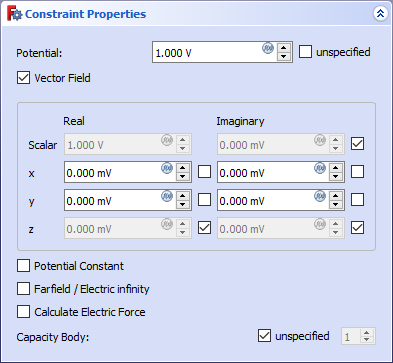|
|
| Menu location |
|---|
| Model → Electromagnetic boundary conditions → Electrostatic potential boundary condition |
| Workbenches |
| FEM |
| Default shortcut |
| None |
| Introduced in version |
| - |
| See also |
| FEM capacitance example, FEM tutorial |
| Solvers |
|---|
| Elmer |
Description
Creates a FEM boundary condition for the electrostatic potential. To be used together with the Electrostatic, Electricforce, Magnetodynamic, Magnetodynamic2D or Static current equation.
Usage
- There are several ways to invoke the command:
- Press the
Electrostatic potential boundary condition button.
- Select the Model → Electromagnetic boundary conditions →
Electrostatic potential boundary condition option from the menu.
- Press the
- 1.1 and above: Select a boundary condition type and its parameters:
- Dirichlet - select and specify Potential or Electromagnetic Potential. Optionally, set Electric Infinity and Potential Constant.
- Neumann - specify Electric Flux Density.
- Optionally, define the Capacitance Body.
- Press the Add button.
- In the 3D view select the object the boundary condition should be applied to.
Options
The dialog offers the following settings:

- Boundary Condition: To choose between Dirichlet (prescribed potential) and Neumann (prescribed electric flux density) boundary condition type. introduced in 1.1
- Potential: The electric potential in V.
- Electromagnetic Potential: To enable the input of the components of a potential vector field.
- x: The real/imaginary part of the potential in x-direction in V.
For other coordinate systems than Cartesian 3D, this will be the first coordinate of the system instead of x. - y: The real/imaginary part of the potential in y-direction in V.
For other coordinate systems than Cartesian 3D, this will be the second coordinate of the system instead of y. - z: The real/imaginary part of the potential in z-direction in V.
For other coordinate systems than Cartesian 3D, this will be the third coordinate of the system instead of z. If the coordinate system has no third coordinate, this setting will be ignored. - x, y, z checkboxes: To declare the corresponding potential as unknown for the solver.
- Electric Infinity: Option to make a spherical approximation that the volume above the face extends to infinity.
- Potential Constant: Option to set a constant potential.
- Electric Flux Density: The electric flux density (electric displacement field D) in C/m^2. introduced in 1.1
- Capacitance Body: Counter of the body (or face) with a capacitance.
This page is retrieved from https://wiki.freecad.org/FEM_ConstraintElectrostaticPotential